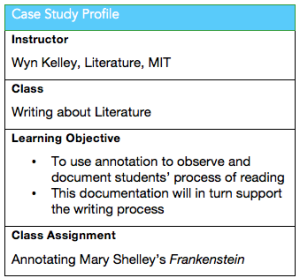 For this five page essay, Prof. Kelley asked her students to annotate Chapter Four of Mary Shelley’s Frankenstein (See assignment here) . They were encouraged to annotate as many details as they wished, making their comments any length. To guide them, Prof. Kelley suggested the following goals:
For this five page essay, Prof. Kelley asked her students to annotate Chapter Four of Mary Shelley’s Frankenstein (See assignment here) . They were encouraged to annotate as many details as they wished, making their comments any length. To guide them, Prof. Kelley suggested the following goals:
- One goal might be to get a variety of different kinds of annotations, from the personal impression, to something that requires looking up information in a dictionary or encyclopedia, to something more reflective or interpretive.
- Another approach might be to note all the examples of a certain phenomenon they noticed: words that speak to different sensory images, for example, or place names, or allusions to other authors, or language reminiscent of details from elsewhere in the novel.
- Or students might want to cover material from various parts of the chapter or alternatively focus on a particular paragraph or moment.
After they had finished their online annotation, students were then tasked with developing the data they generated through this work. Students looked up information to answer questions they had about certain details. They looked for patterns in the details they noticed—certain repetitions of sounds, words, or phrases, or conversely significant breaks or changes in a pattern.
Prof. Kelley encouraged her students to see what questions or discoveries their annotations inspired. Did multiple readings of a certain passage suggest meanings they did not see the first time? Does Shelley use certain references or kinds of language for a particular effect? What parts of the chapter seem most energetic and immediate? Did students see a change from the opening to the closing sentences in the focus of the chapter?
Having taken notes on their annotations, students were then assigned to write a five page paper on what emerged from their study of details in the chapter.

